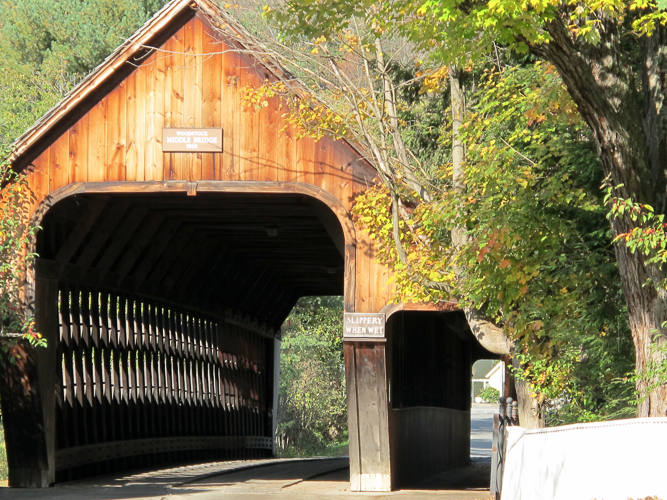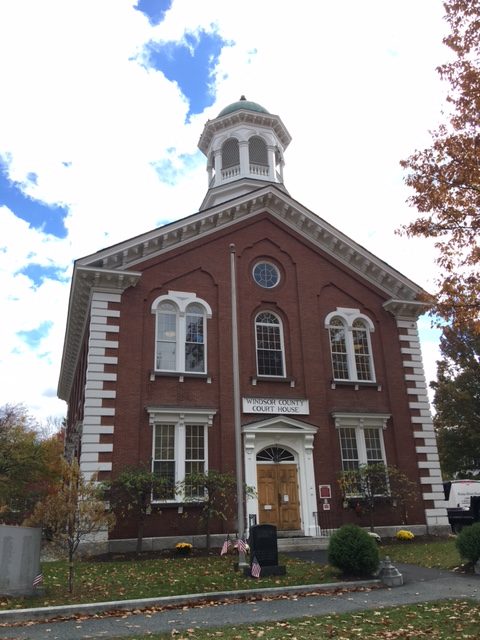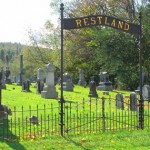 When my ancestors lived in Woodstock, Vermont in 1840, the town was a bustling center for local commerce and culture boasting a population of 3,315.
When my ancestors lived in Woodstock, Vermont in 1840, the town was a bustling center for local commerce and culture boasting a population of 3,315.
“Woodstock Green,” so called, is a beautiful village,” notes The New England Gazetteer, “It is the seat of a flourishing country trade and contains many very handsome buildings.”
I can’t imagine much has changed. It’s still a beautiful New England village. And, in early October it’s a main stop on leaf-peeping tours.
My own autumn visit had a different purpose. Woodstock was an overnight stop en route to the Vermont State Archives, about an hour north in Middlesex. My goal there was to locate two 19th century court case files that might still be tucked away in any number of unprocessed boxes now housed at the archives repository. But, it was Monday and the Archives weren’t open today. So, Woodstock.
Repository #1: The Woodstock History Center
I suggested to my husband that we check out the village shops and restaurants, but he directed the car to a parking spot right in front of the Woodstock History Center, former home of Dana family.
I went archiving and my husband went shopping.
Although we didn’t locate any records related to my elusive female ancestor, Jenny Shurtleff, Assistant Director/Education Coordinator, shared some great tidbits of local lore. I’d been looking for probate records years earlier and heard the “there was a courthouse fire.”
True, she said. In fact, there had been two courthouse fires, the last one in 1854. Right smack after the time period I was researching.
And, if that wasn’t bad enough, a few years later the local newspaper office caught on fire. Which just might explain why some runs of the paper seemed to missing.
Great information. Purely by chance.
Now I want to get back to Woodstock to tour the house and museum and spend some time with the local history collection.
The Woodstock History Center is open May to mid-October, and by appointment. Or, submit a request for long-distance research assistance.
 Repository #2: Woodstock Town Hall
Repository #2: Woodstock Town Hall
Where would I find a wealthy widow in 1840? The census didn’t list a residence address, but perhaps she owned property. Those records were at the Town Hall, office of the Woodstock Town Clerk, just a short walk from the history center.
Nil.
And no property records for her daughter or son-in-law.
 Repository #3: Windsor County Courthouse
Repository #3: Windsor County Courthouse
Another short walk, across The Green to the Windsor County Courthouse. The third building, as I learned, rebuilt after the fires in the 1790s and 1850s. Right next to the beautiful Woodstock Inn, and the Library.
Early Vermont probate files were filed in Probate Districts based on town jurisdiction. In Windsor County, there were two districts, Hartford and Windsor. Early in my research, I discovered a gem resource, the Windsor County Vermont Probate Index 1778-1899, compiled by Scott Andrew Bartley and Marjorie-J. Bartley (Genealogical Society of Vermont, 2000). This thick red volume lives near every archivist’s desk. Mine too.
The “red book” told me that the files for my wealthy widow’s husband, David Childs, should be found in Probate Volume 8. And, according to Bartley, there were no probate packets.
The Town Clerk confirmed, No Probate Packets. She had been to the courthouse basement, she said, and she absolutely positively knew There Were No Probate Packets.
Fortunately, the legal actions seem to have been copied to the Probate Books.
This was different from Rutland County where I found probate records scattered throughout several volumes, recorded (semi) chronologically.
In Rutland, first I’d find the Administration, then the note to take inventory, then filings for extensions, final inventory, sale of real estate, and so on. Often these records would continue for many years.
In contrast, the Hartford District probate records appear as individual recordings of the complete probate file. Records begin with estate name and continues to list each action. I wonder if this record was made and then the packets destroyed.
What’s missing, unfortunately, is the original handwriting, the little slips of paper, the sums calculated in the margins. In other words, the good stuff.
Although I had already located and used the microfilm of this record, I was glad to be able to make digital photos of the recorded pages. The county clerk brought out the book from the vault, and I stood at a little hallway table in the dim light taking snapshots.
 Repository #4: Norman Williams Public Library
Repository #4: Norman Williams Public Library
Next door to the Windsor County Courthouse on The Green, the Norman Williams Public Library is a beautiful stone building housing with a local history room. Unfortunately, that room is the library’s main meeting space and was unavailable to researchers.
One more reason for another visit to Woodstock.
In one morning I managed to visit four repositories in this little village. Although I didn’t locate any new records, I was able to confirm a few ideas. As a bonus, I know where to go for historical context when I’m ready to write the bigger story of my wealthy widow’s life.
On to the the State Archives.






Would you post research tips for Rutland County?
Rutland County is a great place to research. You don’t say if you plan a trip to Vermont or are looking for online research tips, but I’ve done both and will put together a post with some ideas. Feel free to leave more information here about the time period and locality, too.
Thanks for asking!